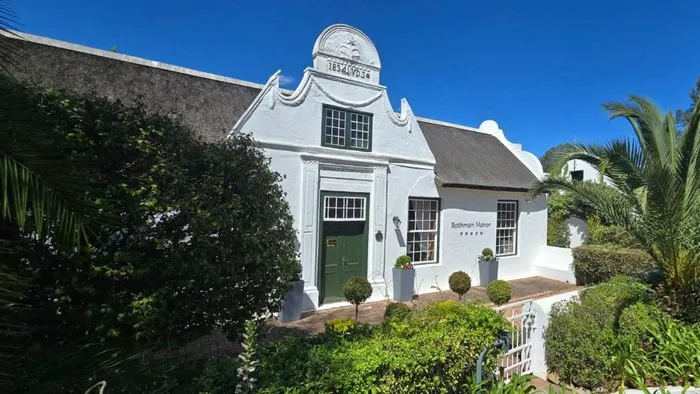Would you like a ghost with your R12.8m Cape Dutch hotel?

The top property listing in Swellendam currently is a Cape Dutch heritage property on a 3.5 ha estate, currently on the market for R12.8 million.
Image: Supplied
The 17th-century Cape Dutch architectural style is proving to be a sound investment, with one on the market for R12.8 million.
The five-star Rothman Manor Boutique Hotel is currently on the market as a going concern.
Seeff said it exemplifies the cachet of these properties, often used as guest houses, wedding venues, or restaurants.
In addition, these homes are also used as offices or, as they were intended, for residential use, said Jaco Badenhorst, sales manager for Seeff Country and Karoo.
Cape Dutch architecture developed in the Western Cape of South Africa from the 17th century onwards.
It blends Dutch, German, French, and Indonesian influences with local materials and environmental needs.
Key features include whitewashed walls, thatched roofs, and distinctive, often ornate, gables that evolved from simple designs in the 17th century to elaborate “holbol” (concave and convex) shapes during the Baroque period and neoclassical styles later on.
Some Cape Dutch attractions in Cape Town can be found at the Vergelegen Wine Estate, the Boschendal Wine Estate, and Buitenverwachting, according to Approach Guides.
Badenhorst added that most of these buildings also offer some historic features such as wooden floors, sash windows, old fireplaces, and perhaps an interesting historical story or two.
The ghost of a man who died in a fall from his horse is said to ride again at Tokai Manor, while Rust en Vreugd is rumoured to be haunted by a ghostly woman.
The intrinsic attraction and historical interest of these properties have driven demand, said Badenhorst. This is especially so among local and international investors seeking income-generating assets.

Fisherman's Cape Dutch cottage
Image: picryl
One aspect of heritage properties which enhances their value is that they are regulated by the National Heritage Resources Act and require permits from provincial heritage authorities for any renovations.
This ensures the properties retain their historic value.
These properties are also quite rare and seldom come onto the market, and when they do, tend to attract strong interest, Badenhorst said.
Early settlement areas around the Cape, Winelands and Overberg tend to have the best-preserved examples of these properties.
Badenhorst said prices tend to vary depending on the location, rarity, condition of the property, and general desirability.
Generally, though, buyers and investors are prepared to pay a premium for the opportunity to own such a unique, historic property, Seeff noted.
Demand for such properties is often particularly pronounced in towns with historical charm coupled with modern convenience, and tourist attractions.
Swellendam, as the third oldest town in the country having been established in 1745, boasts over 50 provincial heritage sites, including the iconic Drostdy Museum and is especially popular, said Seeff.
Badenhorst noted that Swellendam, mainly an agricultural and tourism town, is seeing the average freehold property sell for around R2.3 million.
Luxury homes generally range upwards of R5 million to R15 million, depending on the property.
IOL Business